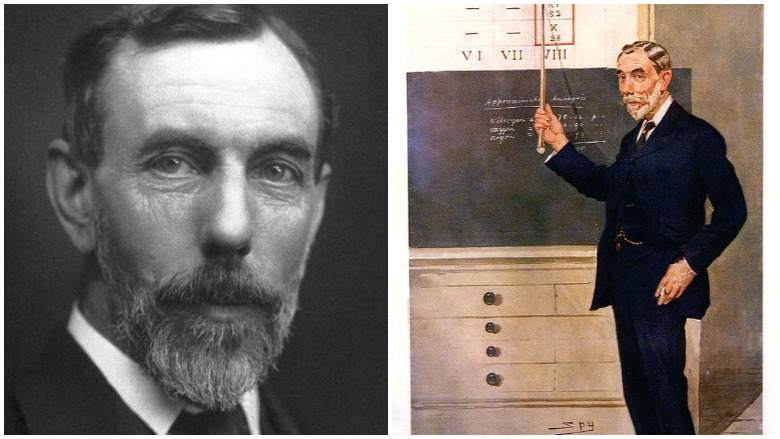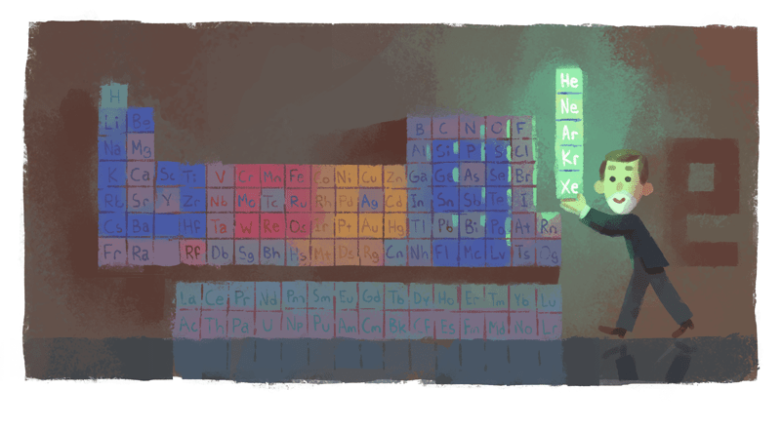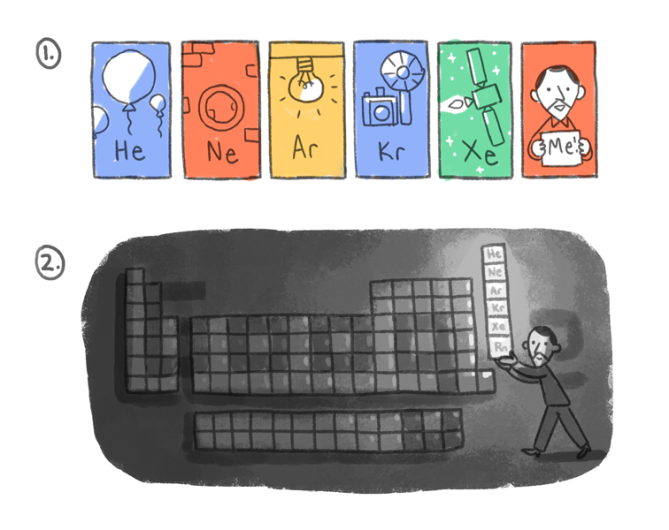
Nobel Prize website/Wikimedia Commons Sir William Ramsay
Sir William Ramsay, a Scottish-born chemist who discovered what are known as the “noble gases,” is honored with a Google Doodle on what would have been his 167th birthday. If you’re not sure what a noble gas is, think of a gas like helium. He helped shape the modern periodic table of elements.
According to Google, Ramsay, who was born in 1852, founded “groundbreaking advances in thermodynamics and nuclear physics.” He is the winner of the Nobel Prize, was knighted, and was heralded as he “greatest chemical discoverer of his time,” Google wrote.
“Sir William Ramsay was one of the world’s leading scientists at the end of the 19th century, and in a spectacular period of research between 1894 and 1898, he discovered five new elements,” explains the journal article, William Ramsay and the Noble Gases by AG Davies.
“These were the noble gases, helium, neon, argon, krypton, and xenon; they added a whole new group to the Periodic Table of the elements, and provided the keystone to our understanding of the electronic structure of atoms, and the way those electrons bind the atoms together into molecules.”
Here’s what you need to know:
1. Ramsay Once Said He Inherited His ‘Taste for Chemistry’ From Both Sides of His Family

William Ramsay Google Doodle.
According to iNews, William Ramsay was born in Glasgow and raised in the city’s center. He later became a shipbuilder’s apprentice in Govan, the site reported. The Nobel Prize biography for Ramsay says he was the son of William Ramsay, C.E. and Catherine, née Robertson. “He was a nephew of the geologist, Sir Andrew Ramsay,” the site says.
He wasn’t content in that career, though, and later found himself inspired by the chemist Thomas Anderson, under whose tutelage he thrived at the University of Glasgow, where he graduated in 1869. In his Nobel Prize lecture, the transcript of which can be found on the Nobel Prize website, Ramsay explained his influences in great detail.
“My grandfather on my father’s side, William Ramsay, was a chemical manufacturer in Glasgow; he came of a long line of dyers, who carried on their work in Haddington, a small country town in the east of Scotland. He was the first, I believe, to distil wood for the production of pyroligneous acid; and he purified it by ‘torrefying’ the acetate of lime formed by its neutralization, and distilling with oil of vitriol. He also was the first to manufacture bichrome; and for many years, he and his partners, the Messrs. Turnbull, made ‘Turnbull’s blue,'” he said.
His mother’s father was also an inspiration, he said, describing him as “a medical man, practising in Edinburgh. He was the author of a series of textbooks for medical students, one of which was entitled Colloquia Chymica. Hence, I inherited the taste for chemistry from my ancestors on both sides of the family.”
2. Ramsay Received a Doctorate in Germany & Published Research While Working at a London College

Google Doodle
Sir William Ramsay was steeped in the world of academia. He earned a doctorate in Germany at the University of Tübingen, according to Google, and “returned home with a reputation for innovative experimental techniques.” It was there that he laid part of the foundation for his later discoveries.
“While there his thesis on orthotoluic acid and its derivatives earned him the degree of doctor of philosophy,” the Nobel bio says.
His eventual stop was London’s University College, where, as chair of the chemistry department, he published books and conducted research on “liquids and vapors,” Google reported. Those weren’t his only positions in universities, though. He also was assistant in chemistry at the Anderson College in Glasgow and was Principal and Professor of Chemistry at University College, Bristol, Nobel’s bio reads.
3. Ramsay Helped Discover Argon & Helium, Among Other Gases
Some of the best-known gases were discovered by Ramsay, in some cases working in conjunction with other scientists. For example, he discovered argon and helium. He wrote a book in 1896 called The Gases of the Atmosphere, which suggested there would be even more “noble gases.”
What are Noble gases? Britannica explains that they are “any of the seven chemical elements that make up Group 18 (VIIIa) of the periodic table. The elements are helium (He), neon (Ne), argon (Ar), krypton (Kr), xenon (Xe), radon (Rn), and oganesson (Og). The noble gases are colourless, odourless, tasteless, nonflammable gases.”
Ramsay and those working with him also identified neon, krypton, and xenon, according to Google. In his Nobel lecture, Ramsay spoke extensively about these gases in ways that only a scientist could probably understand but that capture his great intellect. “Helium, like argon, is a gas, sparingly soluble in water, withstanding the action of oxygen in presence of caustic soda, under the influence of the electric discharge, as well as of red-hot magnesium. Like argon, the ratio of its specific heat at constant volume to that at constant pressure shows it to be a monatomic element, the atom and the molecule being the same,” he said.
He continued, “These properties in common made it evident that helium and argon belong to the same natural family; and it was also obvious that there must exist at least three other elements of the same class; this is evident on inspection of the periodic table where the following elements are in apposition.”
4. Ramsay Was Awarded the Nobel Prize for His Discovery of ‘Inert Gaseous Elements in Air’

Helium on the periodic table.
According to the Nobel Prize website, The Nobel Prize in Chemistry 1904 was awarded to Sir William Ramsay “in recognition of his services in the discovery of the inert gaseous elements in air, and his determination of their place in the periodic system.”
The website says that Ramsay was affiliated with University College, London, United Kingdom, when he won the Nobel Prize. He died on July 23 1916 in High Wycombe, United Kingdom, the site reports.
“It was however in inorganic chemistry that his most celebrated discoveries were made. As early as 1885-1890 he published several notable papers on the oxides of nitrogen and followed those up with the discovery of argon, helium, neon, krypton, and xenon,” says the Nobel bio (Nobel Lectures, Chemistry 1901-1921, Elsevier Publishing Company, Amsterdam, 1966.)
5. Ramsay, Who Also Loved Studying Languages, Was Married & Had Two Children

Sir William Ramsay
Ramsay was married to Margaret, described by the Nobel bio as “the daughter of George Stevenson Buchanan.” They had two children. He also enjoyed traveling and languages, the site reports.
The Davis article describes Ramsay as “a man of great charm, a good linguist, and a composer and performer of music, poetry and song.”
You can see a timeline of Ramsay’s career here, as well as a list of his publications.
READ NEXT: The Life of Junko Tabei.